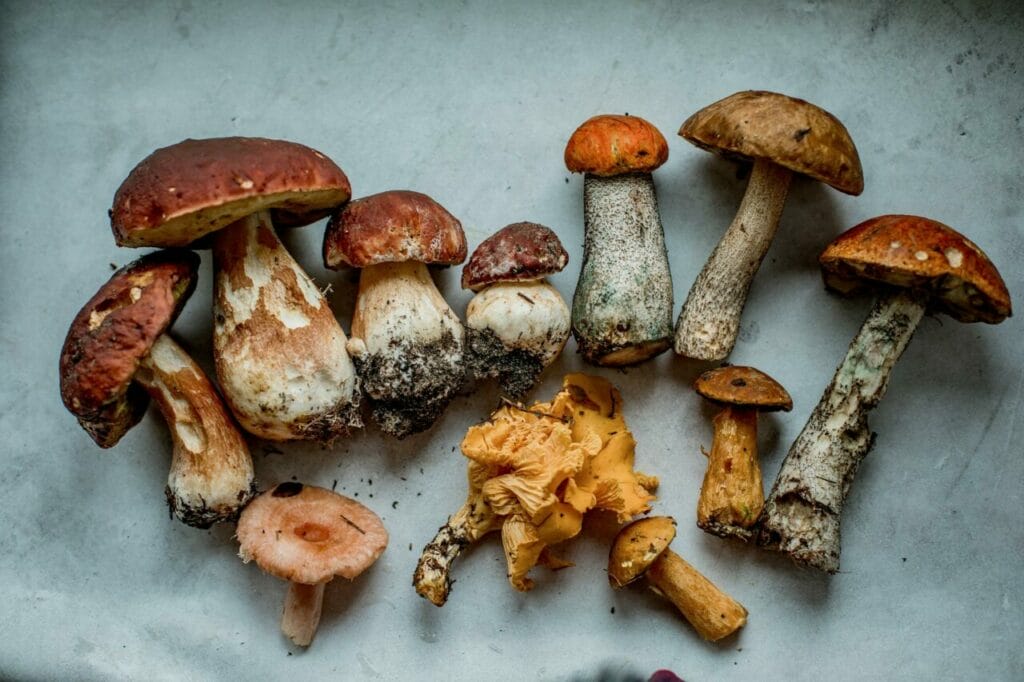Common methods of treating anxiety include medication and therapy, though they might not be suitable for everyone due to potential adverse effects. Such issues have sparked a growing interest in alternative solutions, such as psychedelic therapy, which employs substances like “magic mushrooms Montreal” and others.
We are your premier destination to buy psychedelics online in Canada. Our services are quick, secure, and unobtrusive.
[toc]Key Points:
- Psychedelic therapy combines the healing benefits of psychedelic substances and traditional talk therapy to help facilitate the healing process.
- Psychedelic therapy can boost emotional wellbeing and overall quality of life through spiritual journeys.
- The integration process, an essential technique in psychedelic therapy, is aimed at ensuring the long-term success of the therapy session.

Statistics on Anxiety Disorders in Canada
According to the 2022 Mental Health and Access to Care Survey, there has been a concerning increase in the prevalence of anxiety disorders in Canada. The proportion of Canadians aged 15 and older who were diagnosed with generalized anxiety disorder in the 12 months preceding the survey has risen from 2.6% in 2012 to 5.2% in 2022.
Contrasting Traditional Treatment with Psychedelic Therapy
Standard treatments for anxiety disorders generally combine psychotherapy and medication. Psychotherapy, also referred to as psychological counselling, is a collaborative process between a therapist and the patient to mitigate anxiety symptoms.
On the other hand, anxiety medications manage symptoms by tailoring the treatment to the specific type of anxiety disorder and considering any concurrent mental or physical health conditions. Despite the treatment being case-specific, psychotherapy and medication form the basic approaches.
In psychedelic therapy, sessions are unique as they include one or two doses of a psychedelic substance, in addition to other therapeutic
Techniques:
The Role of Psychedelics in Therapy
Psychedelic therapy is a unique therapeutic method that employs the use of psychedelic substances to enhance the healing process. These substances, known for their hallucinogenic properties, have been a part of holistic medical practices and spiritual rituals across different cultures for centuries.
The two primary substances used in this therapeutic approach are Lysergic acid diethylamide (LSD) and psilocybin. LSD is known to induce changes in mood, perception, and consciousness. On the other hand, psilocybin is the active compound in magic mushrooms, as mentioned on the Health Canada website. Consuming these mushrooms can stimulate sensory perceptions, leading to visual, auditory, or tactile hallucinations.
Determining Dosage for Multiple Sessions
In psychedelic therapy, professionals assess patients to determine the appropriate psilocybin dosage for their sessions. The dosage varies among individuals, with some starting at moderate levels, while others can handle higher amounts. The typical treatment plan includes one to three medication sessions, each lasting six to eight hours with breaks of several weeks in between. This differs from traditional medications that require daily intake until further notice from a healthcare provider.
Experiencing Spiritual and Life-Changing Moments
Unlike anxiety medications that only manage symptoms, therapy aims to tackle the root causes of the condition. Psychedelic therapy can have a significant impact on emotional health and the quality of life.
The immersive experiences can yield profound insights, elevate self-awareness, and enhance emotional processing. These effects can promote personal growth, inspire positive behavioral changes, and improve overall mental health.
Potential Effects
| Broadened Consciousness | Altered states of consciousness can provide a new perspective on the world. | Increased awareness often leads to:Deep insightsEpiphaniesImproved understanding of oneself and the surrounding environment |
| Emotional Healing | Enables emotional healing by allowing individuals to face and process unresolved trauma, grief, or emotional distress. | Through this process, users may experience:Access to deeply suppressed emotionsRelease of emotional blockagesImproved emotional well-being |
| Heightened Self-Awareness | Enhances connectivity among sensory brain regions while reducing connectivity within the default mode network. This network integrates brain regions associated with self-reflection and personal perception.” | These areas aim to: Transform negative thought processes, beliefs, and habitual behaviours. Empower users to gain profound insights into their authentic selves, motivating factors, and social interactions. |
Somatic Therapy
Somatic therapy, while not traditionally linked with psychedelic therapy, is gaining recognition for its potential benefits. This body-centric approach explores the connection between the mind and body. It builds upon the idea that past traumas can result in sensations remaining trapped within the body. Somatic therapists guide individuals in identifying these bodily sensations and use therapeutic methods to alleviate this tension.
Integration
This provides a medium for clients to attain clarity, adopt perspective, and cultivate wisdom from their psychedelic experiences. The transformational process occurs during integration sessions between the therapist and the client, and the client’s proactive measures outside of psychedelic explorations. Integration intensifies the transformative effects of psychedelics through active engagement with surfaced insights and emotional discoveries.
Types of Integration
- Journaling. By documenting experiences, individuals can reinforce memories for easier future reference. It also enables clients to examine their experiences from various perspectives to reveal different interpretations, meanings, and relationships.
- Art. This method provides an effective way to capture the complex feelings and emotions of a psychedelic journey in a creative and visually expressive manner.
- Practicing Nature-based Approaches. These can be as simple as mindful walks in the forest or seeking tranquility near a calm body of water. Therapists can help clients identify intricate patterns within nature or suggest the use of natural elements like plants, stones, water, and candles as grounding tools.
- Engaging in Integration Groups. Group sessions with individuals who have had similar experiences offer a crucial opportunity for reflection, support, and connection. The ability of psychedelic therapy to foster a sense of interdependence and shared understanding beyond personal boundaries is fundamental.
The Role of These Techniques in Anxiety Treatment
The primary pharmacological principle behind all psychedelics is their ability to act as agonists, or stimulators, of serotonin (5-HT) 2A
Psilocybin, a primary active compound found within certain magic mushrooms, has a profound impact on the serotonin 2A receptor. A significant area of psychedelic research concerns its effects on the brain’s default mode network. This network plays a crucial role in repetitive thinking and has been linked with mental health conditions like depression and anxiety. Therapy involving psilocybin can significantly reduce anxiety, with the beneficial effects lasting up to a year after treatment.
After a psilocybin session, often characterized by intense spiritual experiences, patients participate in a conversation with their therapist. In these therapeutic discussions, skilled healthcare professionals focus on understanding the patient’s experiences. They also employ specific strategies to enhance the positive outcomes of the treatment.
These strategies work together to help anxiety sufferers achieve long-term relief in fewer sessions than traditional treatments.
Step by Step Towards a Transformed Reality
Many people rely on traditional treatments for anxiety, but these methods may not be effective or satisfactory for all. Psychedelic therapy provides an alternative solution, using innovative approaches that can lead to life-changing experiences. These methods work together to yield significant, long-lasting results—sometimes for up to a year after just one to three sessions.
Beyond improving mental health, this therapy could also lead to substantial cost savings for patients. Ready to embark on a new journey to health and wellbeing? Discover the possibilities of psychedelic therapy with Powerful Magic Mushrooms Canada.
Commonly Asked Questions
Is a particular species of magic mushroom used for psychedelic therapy?
In research studies on psychedelic-assisted therapy, the specific type of mushroom used is often not mentioned. However, Psilocybe cubensis is typically the mushroom of choice.
Online magic mushroom dispensaries offer a variety of strains to cater to diverse preferences. You have the freedom to choose any strain to feel the therapeutic benefits of psychedelics. But be sure to select a reputable supplier to avoid purchasing unsafe magic mushrooms from dubious sources.
What is the duration of psychedelic therapy?
The length of psychedelic therapy can vary as it comprises several stages. A single session when the psychedelic is ingested lasts between 4 to 8 hours. The entire therapy process, which includes preparation, the session, and follow-up discussions, can span from a few weeks to several months.
As for the lasting effects, people have reported improvements in their mental health for several months or even up to a year after therapy.
After just a year or a few sessions, significant results can be observed.A limited number of sessions are included in this duration.
Does the therapist guide the patient throughout their spiritual journey?
During these sessions, professionals like therapists or other staff members often guide the patient. Studies suggest that Spiritual Health Practitioners (SHPs) offer unique and beneficial insights to improve participants’ wellbeing and support their progress during a spiritual journey. Some people choose to seek help from an SHP, while others rely on the therapist or specialist available.
Is the concept of “set and setting” integrated into the process of psychedelic therapy?
Yes, both the individual’s mindset (set) and the physical environment (setting) play vital roles in safely facilitating spiritual experiences during a psychedelic therapy session. The person’s mental condition directs their spiritual journey, influencing the experience both before and during the psychedelic session. Factors such as beliefs, expectations, emotional states, and intentions determine the course and depth of the experience.
Primary Source: Psychedelics as Emerging Treatments for Anxiety Disorders: Opportunities and Challenges in a Budding Field – PMC (nih.gov)
About the Authors:
Franklin King, IV, MD. and Rebecca Hammond, M.D.
Related Articles:





